Business and the Business Environment Report - Icon College, 2019
VerifiedAdded on 2023/01/18
|19
|6710
|89
Report
AI Summary
This report examines the business environment, focusing on Vodafone Group Plc as a case study. It begins by defining different organizational types (private, public, and voluntary) and their legal structures, using Vodafone, the Bank of England, and Save the Children as examples. The report explores the purposes and scopes of these organizations, their stakeholders, and the relationships between various organizational functions and objectives. Furthermore, it delves into the macro environment, identifying its positive and negative impacts on business operations through PESTEL analysis. The report also conducts a SWOT analysis to determine Vodafone's internal strengths and weaknesses and their interrelation with external macro factors. The analysis covers the size and scope of the organizations along with their vision and mission. The report concludes by summarizing the key findings and providing a reference list.
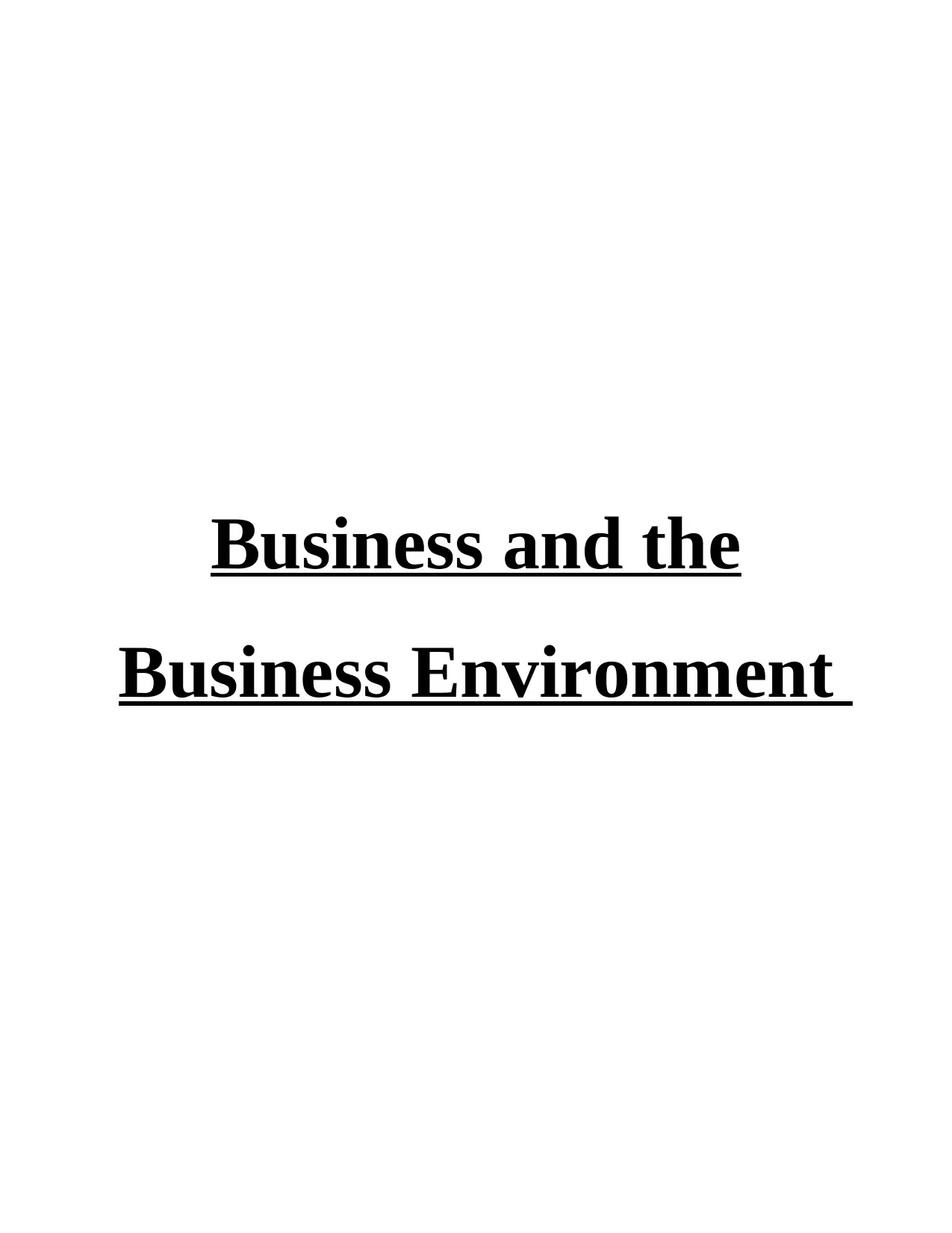
Business and the
Business Environment
Business Environment
Paraphrase This Document
Need a fresh take? Get an instant paraphrase of this document with our AI Paraphraser
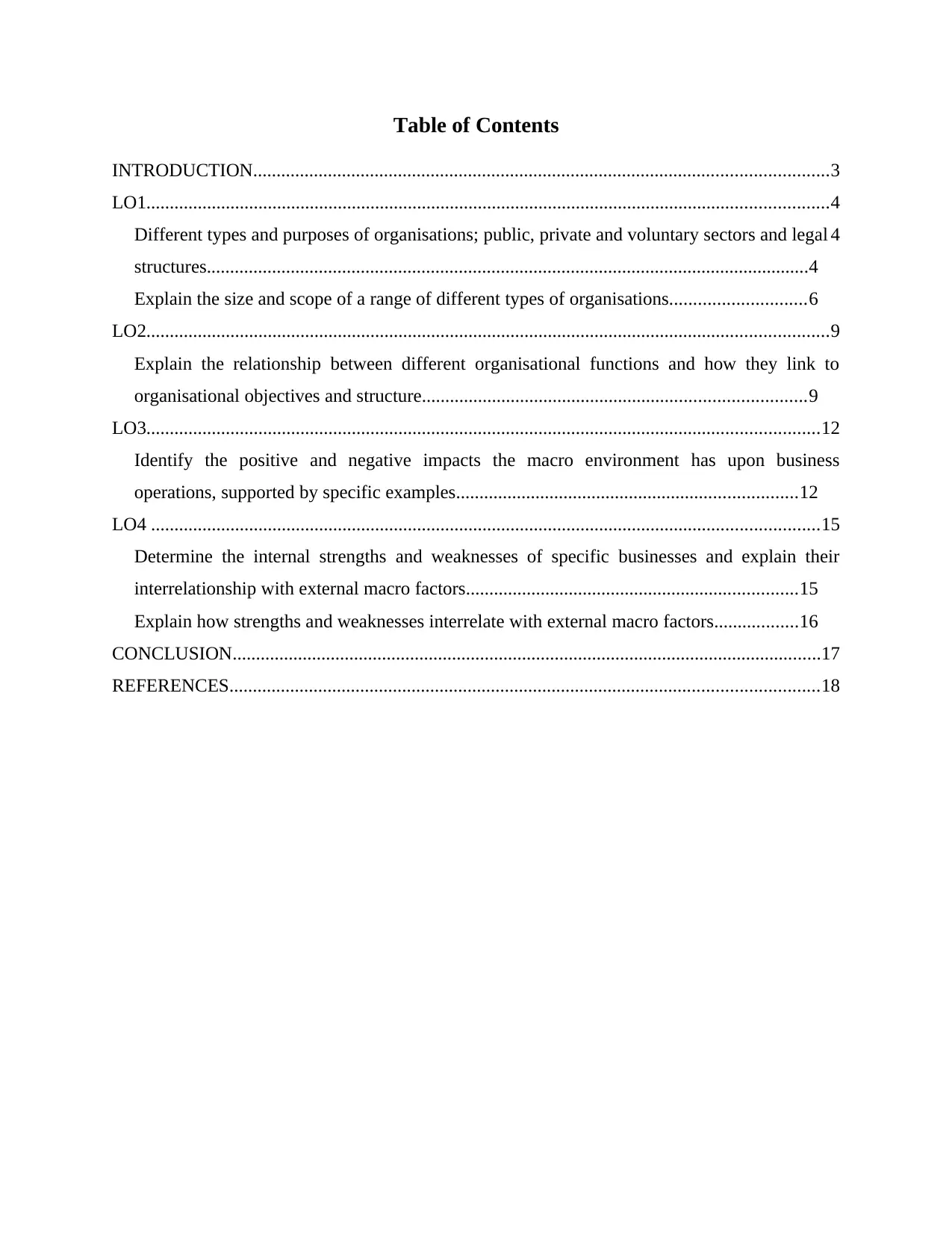
Table of Contents
INTRODUCTION...........................................................................................................................3
LO1..................................................................................................................................................4
Different types and purposes of organisations; public, private and voluntary sectors and legal 4
structures.................................................................................................................................4
Explain the size and scope of a range of different types of organisations.............................6
LO2..................................................................................................................................................9
Explain the relationship between different organisational functions and how they link to
organisational objectives and structure..................................................................................9
LO3................................................................................................................................................12
Identify the positive and negative impacts the macro environment has upon business
operations, supported by specific examples.........................................................................12
LO4 ...............................................................................................................................................15
Determine the internal strengths and weaknesses of specific businesses and explain their
interrelationship with external macro factors.......................................................................15
Explain how strengths and weaknesses interrelate with external macro factors..................16
CONCLUSION..............................................................................................................................17
REFERENCES..............................................................................................................................18
INTRODUCTION...........................................................................................................................3
LO1..................................................................................................................................................4
Different types and purposes of organisations; public, private and voluntary sectors and legal 4
structures.................................................................................................................................4
Explain the size and scope of a range of different types of organisations.............................6
LO2..................................................................................................................................................9
Explain the relationship between different organisational functions and how they link to
organisational objectives and structure..................................................................................9
LO3................................................................................................................................................12
Identify the positive and negative impacts the macro environment has upon business
operations, supported by specific examples.........................................................................12
LO4 ...............................................................................................................................................15
Determine the internal strengths and weaknesses of specific businesses and explain their
interrelationship with external macro factors.......................................................................15
Explain how strengths and weaknesses interrelate with external macro factors..................16
CONCLUSION..............................................................................................................................17
REFERENCES..............................................................................................................................18
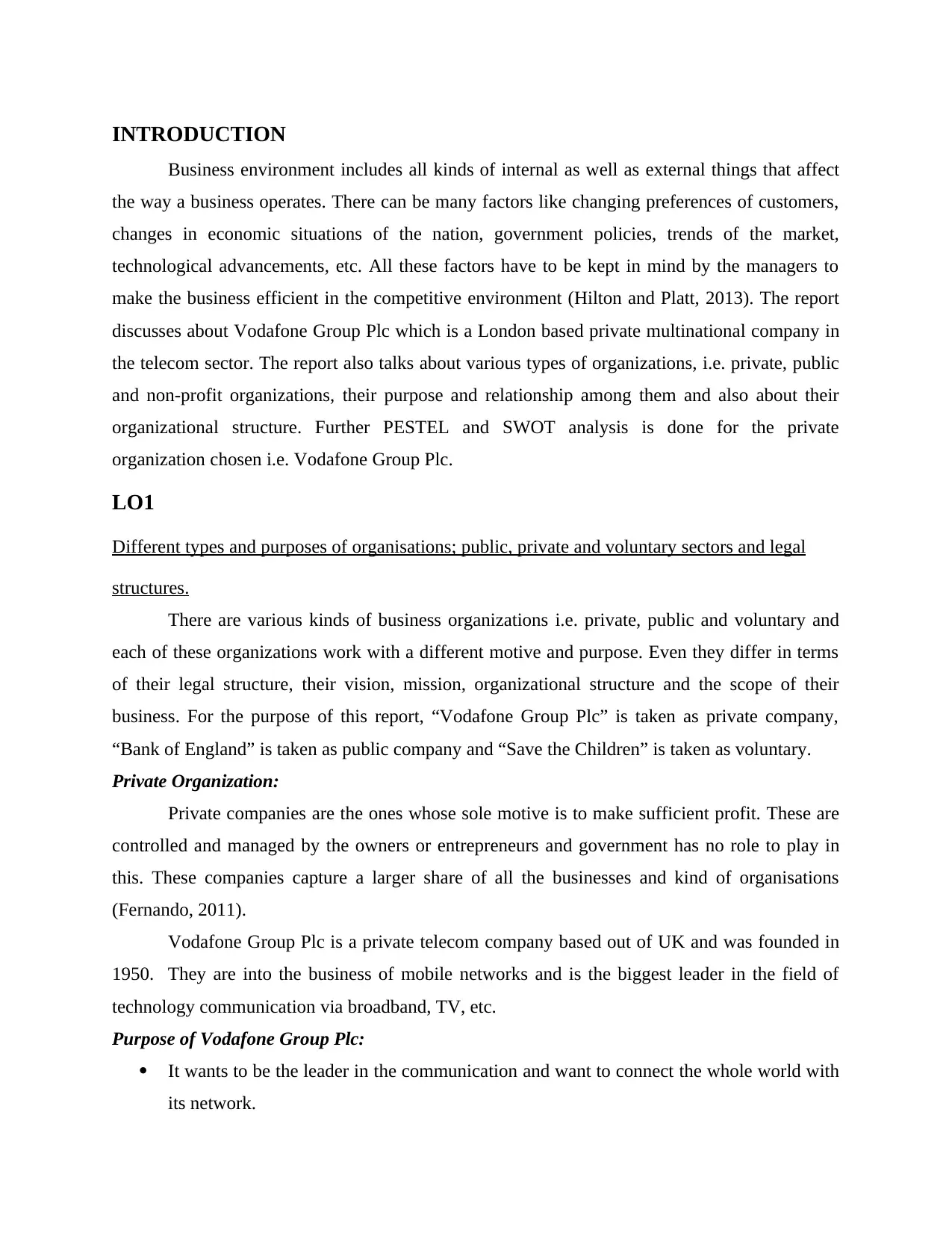
INTRODUCTION
Business environment includes all kinds of internal as well as external things that affect
the way a business operates. There can be many factors like changing preferences of customers,
changes in economic situations of the nation, government policies, trends of the market,
technological advancements, etc. All these factors have to be kept in mind by the managers to
make the business efficient in the competitive environment (Hilton and Platt, 2013). The report
discusses about Vodafone Group Plc which is a London based private multinational company in
the telecom sector. The report also talks about various types of organizations, i.e. private, public
and non-profit organizations, their purpose and relationship among them and also about their
organizational structure. Further PESTEL and SWOT analysis is done for the private
organization chosen i.e. Vodafone Group Plc.
LO1
Different types and purposes of organisations; public, private and voluntary sectors and legal
structures.
There are various kinds of business organizations i.e. private, public and voluntary and
each of these organizations work with a different motive and purpose. Even they differ in terms
of their legal structure, their vision, mission, organizational structure and the scope of their
business. For the purpose of this report, “Vodafone Group Plc” is taken as private company,
“Bank of England” is taken as public company and “Save the Children” is taken as voluntary.
Private Organization:
Private companies are the ones whose sole motive is to make sufficient profit. These are
controlled and managed by the owners or entrepreneurs and government has no role to play in
this. These companies capture a larger share of all the businesses and kind of organisations
(Fernando, 2011).
Vodafone Group Plc is a private telecom company based out of UK and was founded in
1950. They are into the business of mobile networks and is the biggest leader in the field of
technology communication via broadband, TV, etc.
Purpose of Vodafone Group Plc:
It wants to be the leader in the communication and want to connect the whole world with
its network.
Business environment includes all kinds of internal as well as external things that affect
the way a business operates. There can be many factors like changing preferences of customers,
changes in economic situations of the nation, government policies, trends of the market,
technological advancements, etc. All these factors have to be kept in mind by the managers to
make the business efficient in the competitive environment (Hilton and Platt, 2013). The report
discusses about Vodafone Group Plc which is a London based private multinational company in
the telecom sector. The report also talks about various types of organizations, i.e. private, public
and non-profit organizations, their purpose and relationship among them and also about their
organizational structure. Further PESTEL and SWOT analysis is done for the private
organization chosen i.e. Vodafone Group Plc.
LO1
Different types and purposes of organisations; public, private and voluntary sectors and legal
structures.
There are various kinds of business organizations i.e. private, public and voluntary and
each of these organizations work with a different motive and purpose. Even they differ in terms
of their legal structure, their vision, mission, organizational structure and the scope of their
business. For the purpose of this report, “Vodafone Group Plc” is taken as private company,
“Bank of England” is taken as public company and “Save the Children” is taken as voluntary.
Private Organization:
Private companies are the ones whose sole motive is to make sufficient profit. These are
controlled and managed by the owners or entrepreneurs and government has no role to play in
this. These companies capture a larger share of all the businesses and kind of organisations
(Fernando, 2011).
Vodafone Group Plc is a private telecom company based out of UK and was founded in
1950. They are into the business of mobile networks and is the biggest leader in the field of
technology communication via broadband, TV, etc.
Purpose of Vodafone Group Plc:
It wants to be the leader in the communication and want to connect the whole world with
its network.
⊘ This is a preview!⊘
Do you want full access?
Subscribe today to unlock all pages.

Trusted by 1+ million students worldwide
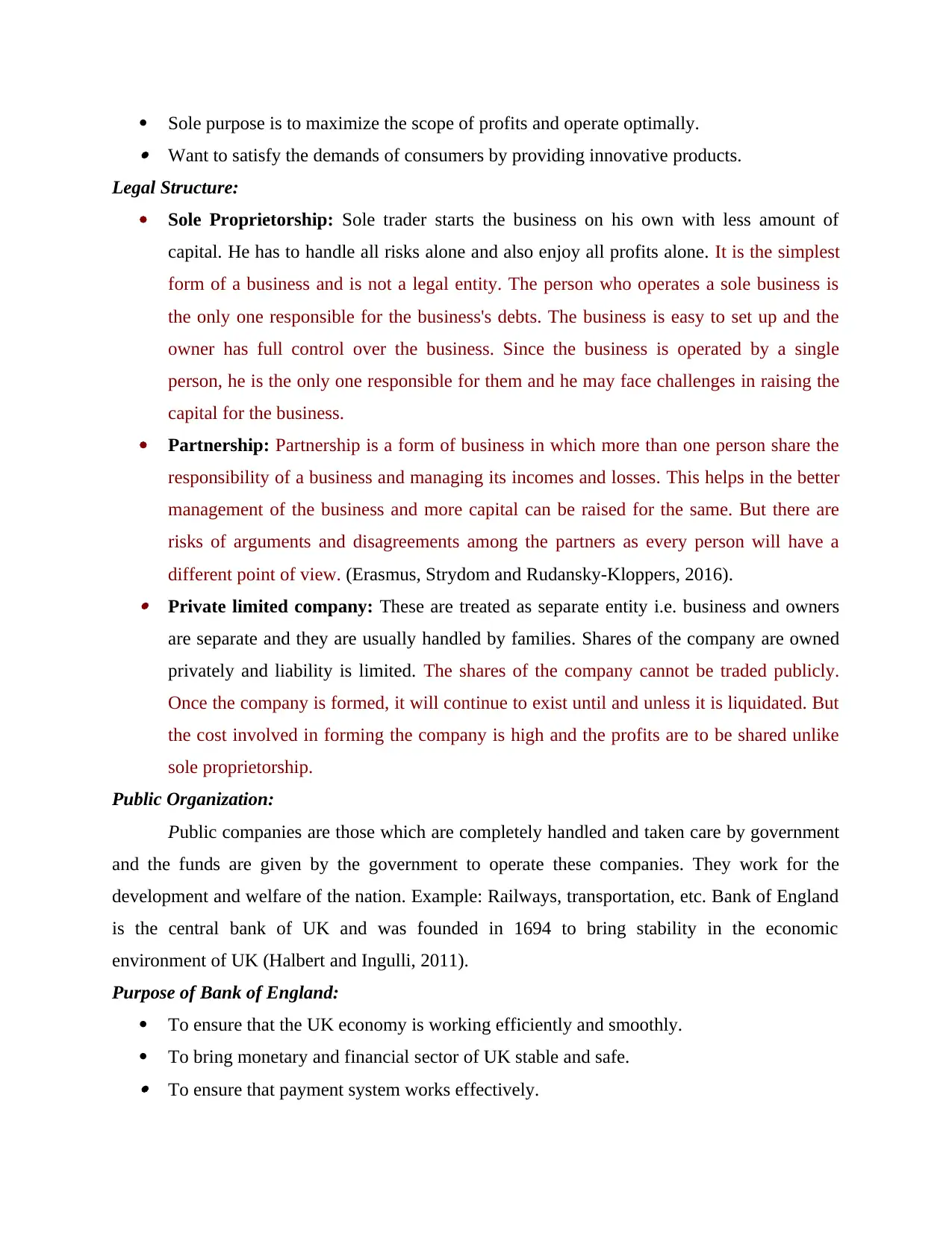
Sole purpose is to maximize the scope of profits and operate optimally. Want to satisfy the demands of consumers by providing innovative products.
Legal Structure:
Sole Proprietorship: Sole trader starts the business on his own with less amount of
capital. He has to handle all risks alone and also enjoy all profits alone. It is the simplest
form of a business and is not a legal entity. The person who operates a sole business is
the only one responsible for the business's debts. The business is easy to set up and the
owner has full control over the business. Since the business is operated by a single
person, he is the only one responsible for them and he may face challenges in raising the
capital for the business.
Partnership: Partnership is a form of business in which more than one person share the
responsibility of a business and managing its incomes and losses. This helps in the better
management of the business and more capital can be raised for the same. But there are
risks of arguments and disagreements among the partners as every person will have a
different point of view. (Erasmus, Strydom and Rudansky-Kloppers, 2016). Private limited company: These are treated as separate entity i.e. business and owners
are separate and they are usually handled by families. Shares of the company are owned
privately and liability is limited. The shares of the company cannot be traded publicly.
Once the company is formed, it will continue to exist until and unless it is liquidated. But
the cost involved in forming the company is high and the profits are to be shared unlike
sole proprietorship.
Public Organization:
Public companies are those which are completely handled and taken care by government
and the funds are given by the government to operate these companies. They work for the
development and welfare of the nation. Example: Railways, transportation, etc. Bank of England
is the central bank of UK and was founded in 1694 to bring stability in the economic
environment of UK (Halbert and Ingulli, 2011).
Purpose of Bank of England:
To ensure that the UK economy is working efficiently and smoothly.
To bring monetary and financial sector of UK stable and safe. To ensure that payment system works effectively.
Legal Structure:
Sole Proprietorship: Sole trader starts the business on his own with less amount of
capital. He has to handle all risks alone and also enjoy all profits alone. It is the simplest
form of a business and is not a legal entity. The person who operates a sole business is
the only one responsible for the business's debts. The business is easy to set up and the
owner has full control over the business. Since the business is operated by a single
person, he is the only one responsible for them and he may face challenges in raising the
capital for the business.
Partnership: Partnership is a form of business in which more than one person share the
responsibility of a business and managing its incomes and losses. This helps in the better
management of the business and more capital can be raised for the same. But there are
risks of arguments and disagreements among the partners as every person will have a
different point of view. (Erasmus, Strydom and Rudansky-Kloppers, 2016). Private limited company: These are treated as separate entity i.e. business and owners
are separate and they are usually handled by families. Shares of the company are owned
privately and liability is limited. The shares of the company cannot be traded publicly.
Once the company is formed, it will continue to exist until and unless it is liquidated. But
the cost involved in forming the company is high and the profits are to be shared unlike
sole proprietorship.
Public Organization:
Public companies are those which are completely handled and taken care by government
and the funds are given by the government to operate these companies. They work for the
development and welfare of the nation. Example: Railways, transportation, etc. Bank of England
is the central bank of UK and was founded in 1694 to bring stability in the economic
environment of UK (Halbert and Ingulli, 2011).
Purpose of Bank of England:
To ensure that the UK economy is working efficiently and smoothly.
To bring monetary and financial sector of UK stable and safe. To ensure that payment system works effectively.
Paraphrase This Document
Need a fresh take? Get an instant paraphrase of this document with our AI Paraphraser
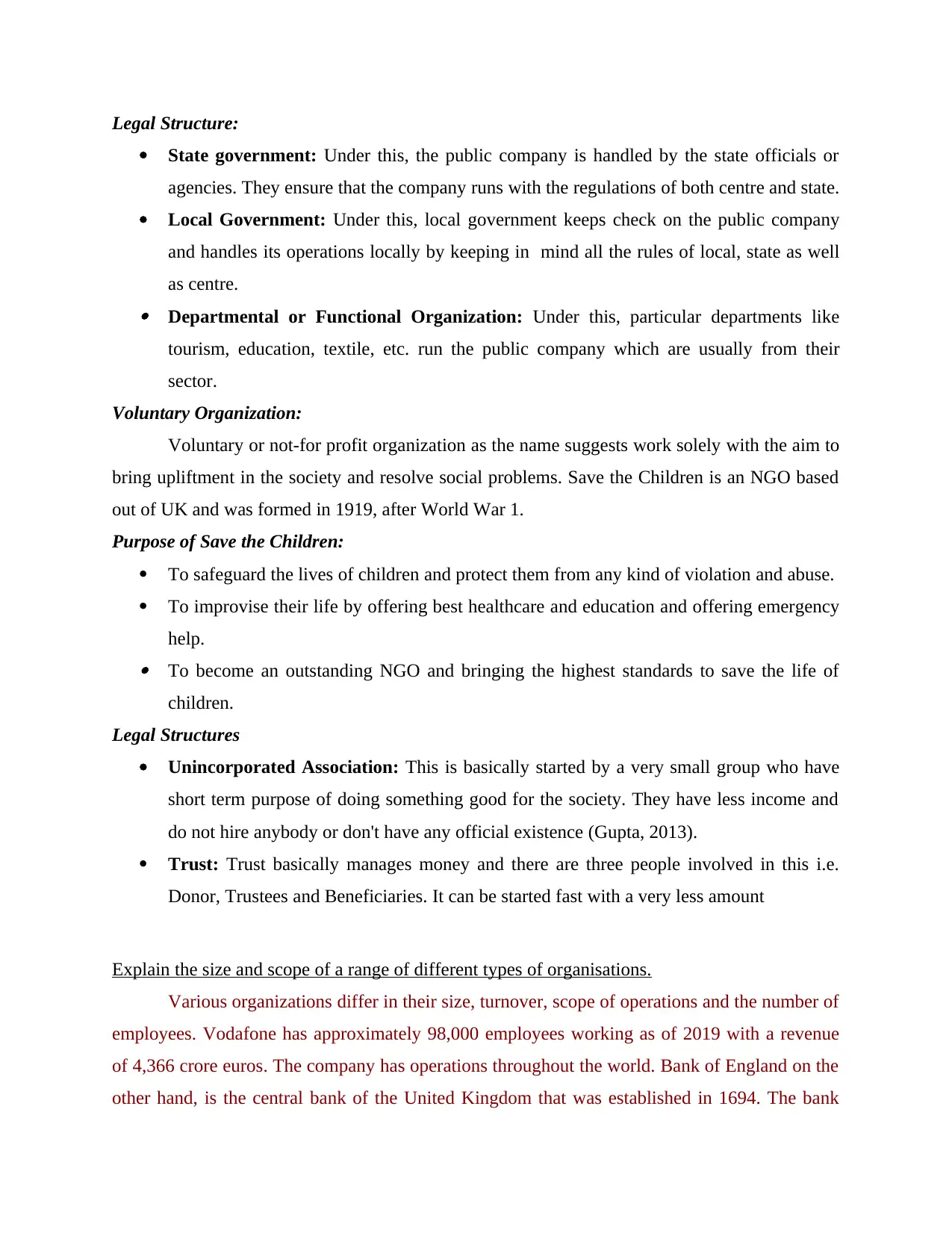
Legal Structure:
State government: Under this, the public company is handled by the state officials or
agencies. They ensure that the company runs with the regulations of both centre and state.
Local Government: Under this, local government keeps check on the public company
and handles its operations locally by keeping in mind all the rules of local, state as well
as centre. Departmental or Functional Organization: Under this, particular departments like
tourism, education, textile, etc. run the public company which are usually from their
sector.
Voluntary Organization:
Voluntary or not-for profit organization as the name suggests work solely with the aim to
bring upliftment in the society and resolve social problems. Save the Children is an NGO based
out of UK and was formed in 1919, after World War 1.
Purpose of Save the Children:
To safeguard the lives of children and protect them from any kind of violation and abuse.
To improvise their life by offering best healthcare and education and offering emergency
help. To become an outstanding NGO and bringing the highest standards to save the life of
children.
Legal Structures
Unincorporated Association: This is basically started by a very small group who have
short term purpose of doing something good for the society. They have less income and
do not hire anybody or don't have any official existence (Gupta, 2013).
Trust: Trust basically manages money and there are three people involved in this i.e.
Donor, Trustees and Beneficiaries. It can be started fast with a very less amount
Explain the size and scope of a range of different types of organisations.
Various organizations differ in their size, turnover, scope of operations and the number of
employees. Vodafone has approximately 98,000 employees working as of 2019 with a revenue
of 4,366 crore euros. The company has operations throughout the world. Bank of England on the
other hand, is the central bank of the United Kingdom that was established in 1694. The bank
State government: Under this, the public company is handled by the state officials or
agencies. They ensure that the company runs with the regulations of both centre and state.
Local Government: Under this, local government keeps check on the public company
and handles its operations locally by keeping in mind all the rules of local, state as well
as centre. Departmental or Functional Organization: Under this, particular departments like
tourism, education, textile, etc. run the public company which are usually from their
sector.
Voluntary Organization:
Voluntary or not-for profit organization as the name suggests work solely with the aim to
bring upliftment in the society and resolve social problems. Save the Children is an NGO based
out of UK and was formed in 1919, after World War 1.
Purpose of Save the Children:
To safeguard the lives of children and protect them from any kind of violation and abuse.
To improvise their life by offering best healthcare and education and offering emergency
help. To become an outstanding NGO and bringing the highest standards to save the life of
children.
Legal Structures
Unincorporated Association: This is basically started by a very small group who have
short term purpose of doing something good for the society. They have less income and
do not hire anybody or don't have any official existence (Gupta, 2013).
Trust: Trust basically manages money and there are three people involved in this i.e.
Donor, Trustees and Beneficiaries. It can be started fast with a very less amount
Explain the size and scope of a range of different types of organisations.
Various organizations differ in their size, turnover, scope of operations and the number of
employees. Vodafone has approximately 98,000 employees working as of 2019 with a revenue
of 4,366 crore euros. The company has operations throughout the world. Bank of England on the
other hand, is the central bank of the United Kingdom that was established in 1694. The bank
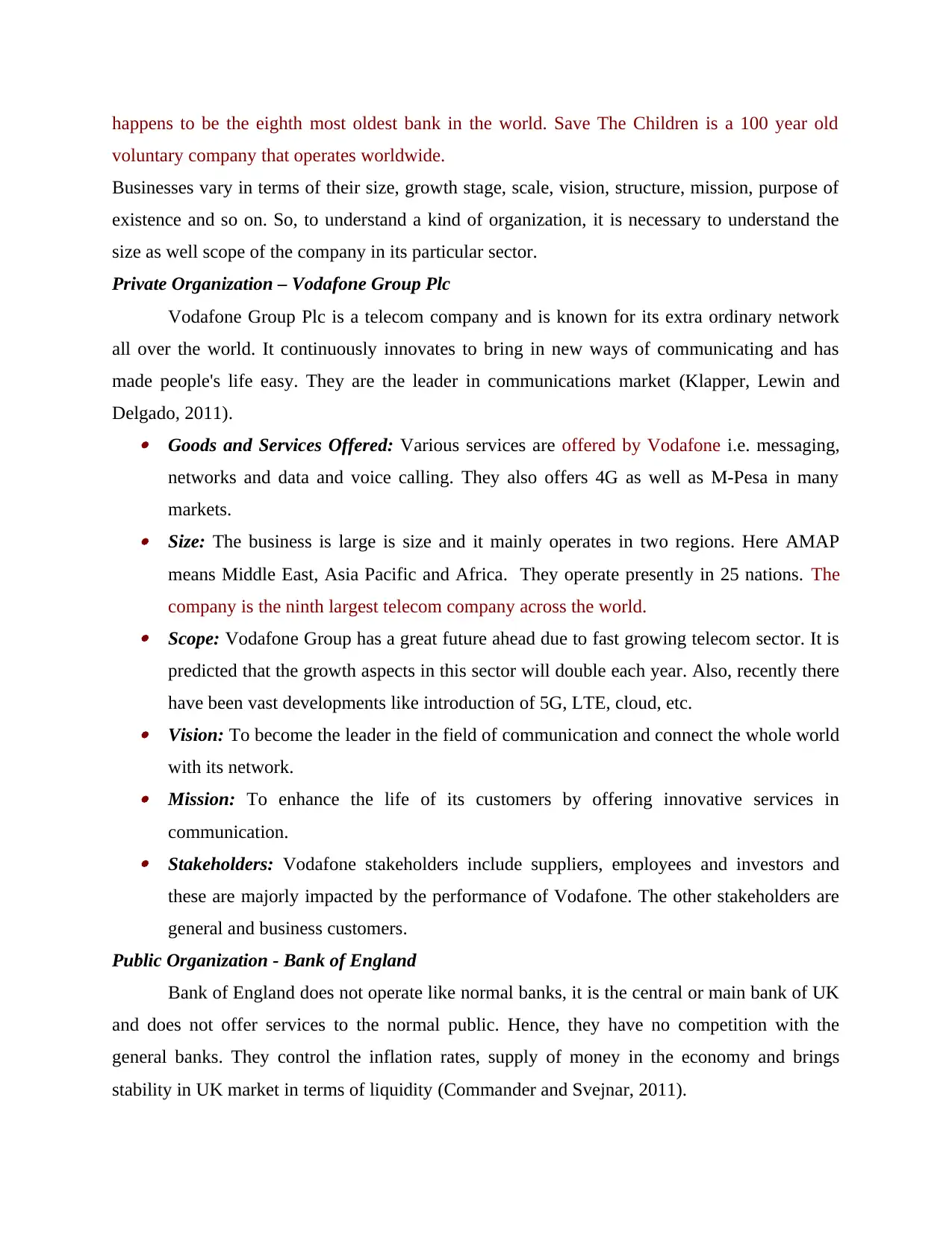
happens to be the eighth most oldest bank in the world. Save The Children is a 100 year old
voluntary company that operates worldwide.
Businesses vary in terms of their size, growth stage, scale, vision, structure, mission, purpose of
existence and so on. So, to understand a kind of organization, it is necessary to understand the
size as well scope of the company in its particular sector.
Private Organization – Vodafone Group Plc
Vodafone Group Plc is a telecom company and is known for its extra ordinary network
all over the world. It continuously innovates to bring in new ways of communicating and has
made people's life easy. They are the leader in communications market (Klapper, Lewin and
Delgado, 2011). Goods and Services Offered: Various services are offered by Vodafone i.e. messaging,
networks and data and voice calling. They also offers 4G as well as M-Pesa in many
markets. Size: The business is large is size and it mainly operates in two regions. Here AMAP
means Middle East, Asia Pacific and Africa. They operate presently in 25 nations. The
company is the ninth largest telecom company across the world. Scope: Vodafone Group has a great future ahead due to fast growing telecom sector. It is
predicted that the growth aspects in this sector will double each year. Also, recently there
have been vast developments like introduction of 5G, LTE, cloud, etc. Vision: To become the leader in the field of communication and connect the whole world
with its network. Mission: To enhance the life of its customers by offering innovative services in
communication. Stakeholders: Vodafone stakeholders include suppliers, employees and investors and
these are majorly impacted by the performance of Vodafone. The other stakeholders are
general and business customers.
Public Organization - Bank of England
Bank of England does not operate like normal banks, it is the central or main bank of UK
and does not offer services to the normal public. Hence, they have no competition with the
general banks. They control the inflation rates, supply of money in the economy and brings
stability in UK market in terms of liquidity (Commander and Svejnar, 2011).
voluntary company that operates worldwide.
Businesses vary in terms of their size, growth stage, scale, vision, structure, mission, purpose of
existence and so on. So, to understand a kind of organization, it is necessary to understand the
size as well scope of the company in its particular sector.
Private Organization – Vodafone Group Plc
Vodafone Group Plc is a telecom company and is known for its extra ordinary network
all over the world. It continuously innovates to bring in new ways of communicating and has
made people's life easy. They are the leader in communications market (Klapper, Lewin and
Delgado, 2011). Goods and Services Offered: Various services are offered by Vodafone i.e. messaging,
networks and data and voice calling. They also offers 4G as well as M-Pesa in many
markets. Size: The business is large is size and it mainly operates in two regions. Here AMAP
means Middle East, Asia Pacific and Africa. They operate presently in 25 nations. The
company is the ninth largest telecom company across the world. Scope: Vodafone Group has a great future ahead due to fast growing telecom sector. It is
predicted that the growth aspects in this sector will double each year. Also, recently there
have been vast developments like introduction of 5G, LTE, cloud, etc. Vision: To become the leader in the field of communication and connect the whole world
with its network. Mission: To enhance the life of its customers by offering innovative services in
communication. Stakeholders: Vodafone stakeholders include suppliers, employees and investors and
these are majorly impacted by the performance of Vodafone. The other stakeholders are
general and business customers.
Public Organization - Bank of England
Bank of England does not operate like normal banks, it is the central or main bank of UK
and does not offer services to the normal public. Hence, they have no competition with the
general banks. They control the inflation rates, supply of money in the economy and brings
stability in UK market in terms of liquidity (Commander and Svejnar, 2011).
⊘ This is a preview!⊘
Do you want full access?
Subscribe today to unlock all pages.

Trusted by 1+ million students worldwide
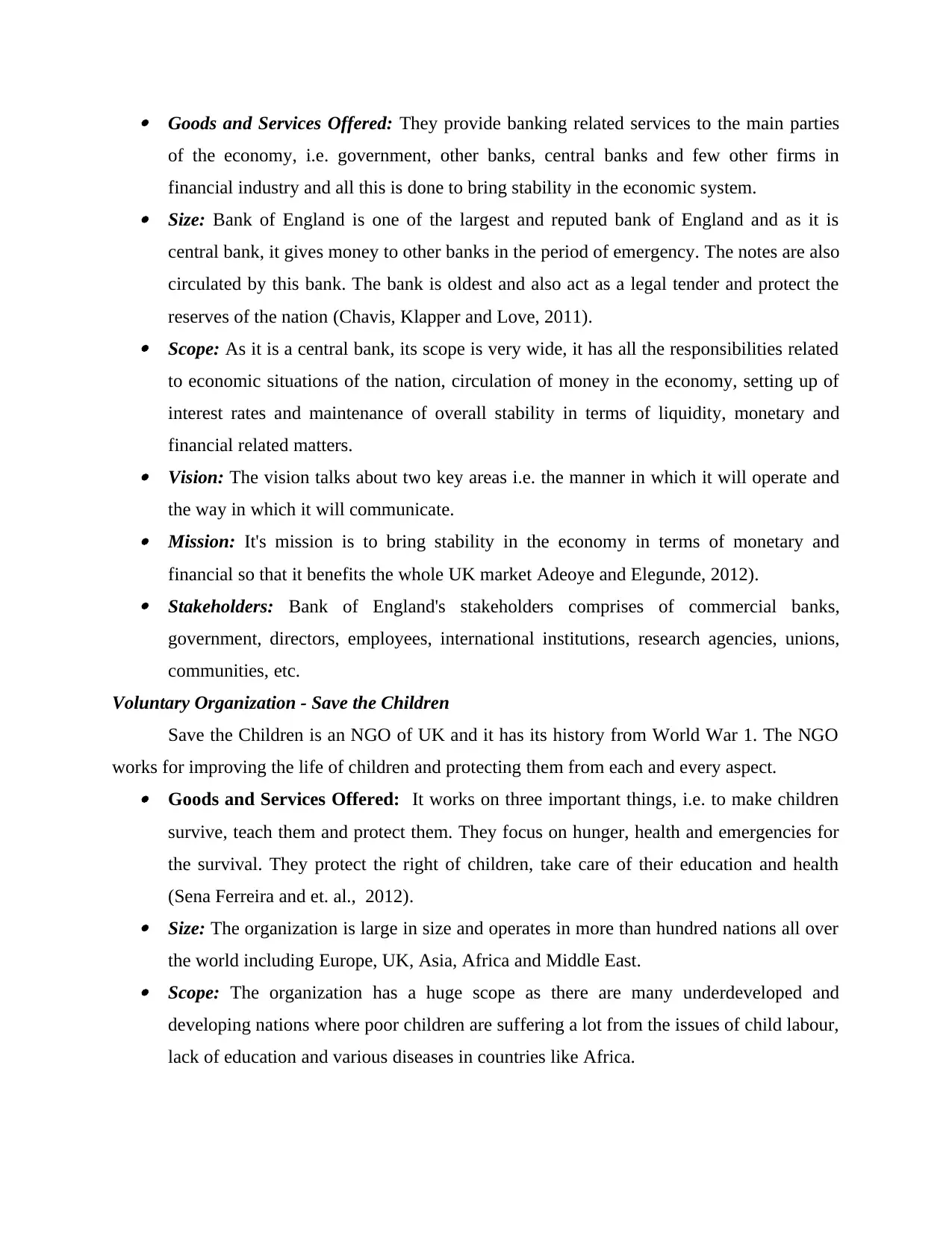
Goods and Services Offered: They provide banking related services to the main parties
of the economy, i.e. government, other banks, central banks and few other firms in
financial industry and all this is done to bring stability in the economic system. Size: Bank of England is one of the largest and reputed bank of England and as it is
central bank, it gives money to other banks in the period of emergency. The notes are also
circulated by this bank. The bank is oldest and also act as a legal tender and protect the
reserves of the nation (Chavis, Klapper and Love, 2011). Scope: As it is a central bank, its scope is very wide, it has all the responsibilities related
to economic situations of the nation, circulation of money in the economy, setting up of
interest rates and maintenance of overall stability in terms of liquidity, monetary and
financial related matters. Vision: The vision talks about two key areas i.e. the manner in which it will operate and
the way in which it will communicate. Mission: It's mission is to bring stability in the economy in terms of monetary and
financial so that it benefits the whole UK market Adeoye and Elegunde, 2012). Stakeholders: Bank of England's stakeholders comprises of commercial banks,
government, directors, employees, international institutions, research agencies, unions,
communities, etc.
Voluntary Organization - Save the Children
Save the Children is an NGO of UK and it has its history from World War 1. The NGO
works for improving the life of children and protecting them from each and every aspect. Goods and Services Offered: It works on three important things, i.e. to make children
survive, teach them and protect them. They focus on hunger, health and emergencies for
the survival. They protect the right of children, take care of their education and health
(Sena Ferreira and et. al., 2012). Size: The organization is large in size and operates in more than hundred nations all over
the world including Europe, UK, Asia, Africa and Middle East. Scope: The organization has a huge scope as there are many underdeveloped and
developing nations where poor children are suffering a lot from the issues of child labour,
lack of education and various diseases in countries like Africa.
of the economy, i.e. government, other banks, central banks and few other firms in
financial industry and all this is done to bring stability in the economic system. Size: Bank of England is one of the largest and reputed bank of England and as it is
central bank, it gives money to other banks in the period of emergency. The notes are also
circulated by this bank. The bank is oldest and also act as a legal tender and protect the
reserves of the nation (Chavis, Klapper and Love, 2011). Scope: As it is a central bank, its scope is very wide, it has all the responsibilities related
to economic situations of the nation, circulation of money in the economy, setting up of
interest rates and maintenance of overall stability in terms of liquidity, monetary and
financial related matters. Vision: The vision talks about two key areas i.e. the manner in which it will operate and
the way in which it will communicate. Mission: It's mission is to bring stability in the economy in terms of monetary and
financial so that it benefits the whole UK market Adeoye and Elegunde, 2012). Stakeholders: Bank of England's stakeholders comprises of commercial banks,
government, directors, employees, international institutions, research agencies, unions,
communities, etc.
Voluntary Organization - Save the Children
Save the Children is an NGO of UK and it has its history from World War 1. The NGO
works for improving the life of children and protecting them from each and every aspect. Goods and Services Offered: It works on three important things, i.e. to make children
survive, teach them and protect them. They focus on hunger, health and emergencies for
the survival. They protect the right of children, take care of their education and health
(Sena Ferreira and et. al., 2012). Size: The organization is large in size and operates in more than hundred nations all over
the world including Europe, UK, Asia, Africa and Middle East. Scope: The organization has a huge scope as there are many underdeveloped and
developing nations where poor children are suffering a lot from the issues of child labour,
lack of education and various diseases in countries like Africa.
Paraphrase This Document
Need a fresh take? Get an instant paraphrase of this document with our AI Paraphraser
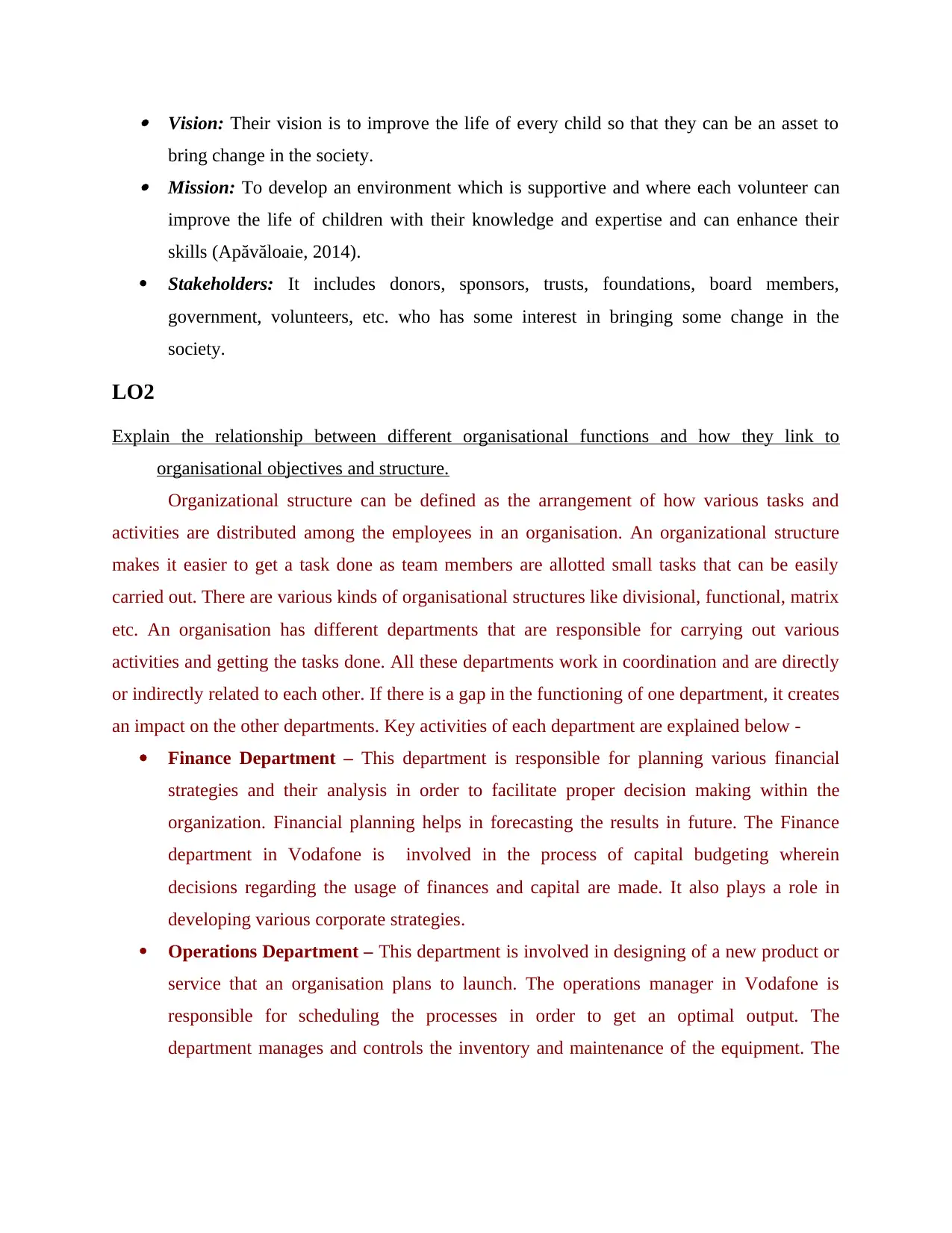
Vision: Their vision is to improve the life of every child so that they can be an asset to
bring change in the society. Mission: To develop an environment which is supportive and where each volunteer can
improve the life of children with their knowledge and expertise and can enhance their
skills (Apăvăloaie, 2014).
Stakeholders: It includes donors, sponsors, trusts, foundations, board members,
government, volunteers, etc. who has some interest in bringing some change in the
society.
LO2
Explain the relationship between different organisational functions and how they link to
organisational objectives and structure.
Organizational structure can be defined as the arrangement of how various tasks and
activities are distributed among the employees in an organisation. An organizational structure
makes it easier to get a task done as team members are allotted small tasks that can be easily
carried out. There are various kinds of organisational structures like divisional, functional, matrix
etc. An organisation has different departments that are responsible for carrying out various
activities and getting the tasks done. All these departments work in coordination and are directly
or indirectly related to each other. If there is a gap in the functioning of one department, it creates
an impact on the other departments. Key activities of each department are explained below -
Finance Department – This department is responsible for planning various financial
strategies and their analysis in order to facilitate proper decision making within the
organization. Financial planning helps in forecasting the results in future. The Finance
department in Vodafone is involved in the process of capital budgeting wherein
decisions regarding the usage of finances and capital are made. It also plays a role in
developing various corporate strategies.
Operations Department – This department is involved in designing of a new product or
service that an organisation plans to launch. The operations manager in Vodafone is
responsible for scheduling the processes in order to get an optimal output. The
department manages and controls the inventory and maintenance of the equipment. The
bring change in the society. Mission: To develop an environment which is supportive and where each volunteer can
improve the life of children with their knowledge and expertise and can enhance their
skills (Apăvăloaie, 2014).
Stakeholders: It includes donors, sponsors, trusts, foundations, board members,
government, volunteers, etc. who has some interest in bringing some change in the
society.
LO2
Explain the relationship between different organisational functions and how they link to
organisational objectives and structure.
Organizational structure can be defined as the arrangement of how various tasks and
activities are distributed among the employees in an organisation. An organizational structure
makes it easier to get a task done as team members are allotted small tasks that can be easily
carried out. There are various kinds of organisational structures like divisional, functional, matrix
etc. An organisation has different departments that are responsible for carrying out various
activities and getting the tasks done. All these departments work in coordination and are directly
or indirectly related to each other. If there is a gap in the functioning of one department, it creates
an impact on the other departments. Key activities of each department are explained below -
Finance Department – This department is responsible for planning various financial
strategies and their analysis in order to facilitate proper decision making within the
organization. Financial planning helps in forecasting the results in future. The Finance
department in Vodafone is involved in the process of capital budgeting wherein
decisions regarding the usage of finances and capital are made. It also plays a role in
developing various corporate strategies.
Operations Department – This department is involved in designing of a new product or
service that an organisation plans to launch. The operations manager in Vodafone is
responsible for scheduling the processes in order to get an optimal output. The
department manages and controls the inventory and maintenance of the equipment. The
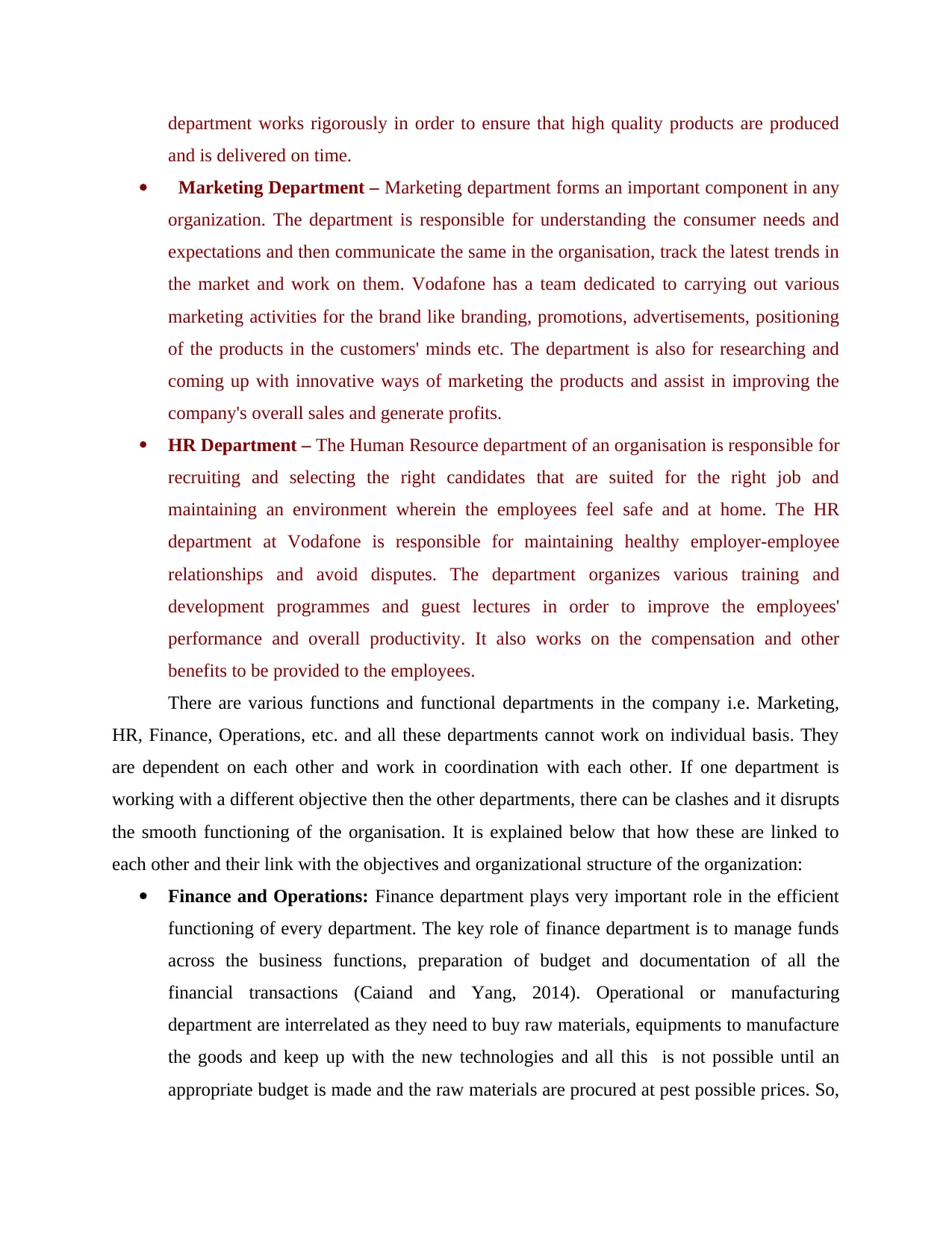
department works rigorously in order to ensure that high quality products are produced
and is delivered on time.
Marketing Department – Marketing department forms an important component in any
organization. The department is responsible for understanding the consumer needs and
expectations and then communicate the same in the organisation, track the latest trends in
the market and work on them. Vodafone has a team dedicated to carrying out various
marketing activities for the brand like branding, promotions, advertisements, positioning
of the products in the customers' minds etc. The department is also for researching and
coming up with innovative ways of marketing the products and assist in improving the
company's overall sales and generate profits.
HR Department – The Human Resource department of an organisation is responsible for
recruiting and selecting the right candidates that are suited for the right job and
maintaining an environment wherein the employees feel safe and at home. The HR
department at Vodafone is responsible for maintaining healthy employer-employee
relationships and avoid disputes. The department organizes various training and
development programmes and guest lectures in order to improve the employees'
performance and overall productivity. It also works on the compensation and other
benefits to be provided to the employees.
There are various functions and functional departments in the company i.e. Marketing,
HR, Finance, Operations, etc. and all these departments cannot work on individual basis. They
are dependent on each other and work in coordination with each other. If one department is
working with a different objective then the other departments, there can be clashes and it disrupts
the smooth functioning of the organisation. It is explained below that how these are linked to
each other and their link with the objectives and organizational structure of the organization:
Finance and Operations: Finance department plays very important role in the efficient
functioning of every department. The key role of finance department is to manage funds
across the business functions, preparation of budget and documentation of all the
financial transactions (Caiand and Yang, 2014). Operational or manufacturing
department are interrelated as they need to buy raw materials, equipments to manufacture
the goods and keep up with the new technologies and all this is not possible until an
appropriate budget is made and the raw materials are procured at pest possible prices. So,
and is delivered on time.
Marketing Department – Marketing department forms an important component in any
organization. The department is responsible for understanding the consumer needs and
expectations and then communicate the same in the organisation, track the latest trends in
the market and work on them. Vodafone has a team dedicated to carrying out various
marketing activities for the brand like branding, promotions, advertisements, positioning
of the products in the customers' minds etc. The department is also for researching and
coming up with innovative ways of marketing the products and assist in improving the
company's overall sales and generate profits.
HR Department – The Human Resource department of an organisation is responsible for
recruiting and selecting the right candidates that are suited for the right job and
maintaining an environment wherein the employees feel safe and at home. The HR
department at Vodafone is responsible for maintaining healthy employer-employee
relationships and avoid disputes. The department organizes various training and
development programmes and guest lectures in order to improve the employees'
performance and overall productivity. It also works on the compensation and other
benefits to be provided to the employees.
There are various functions and functional departments in the company i.e. Marketing,
HR, Finance, Operations, etc. and all these departments cannot work on individual basis. They
are dependent on each other and work in coordination with each other. If one department is
working with a different objective then the other departments, there can be clashes and it disrupts
the smooth functioning of the organisation. It is explained below that how these are linked to
each other and their link with the objectives and organizational structure of the organization:
Finance and Operations: Finance department plays very important role in the efficient
functioning of every department. The key role of finance department is to manage funds
across the business functions, preparation of budget and documentation of all the
financial transactions (Caiand and Yang, 2014). Operational or manufacturing
department are interrelated as they need to buy raw materials, equipments to manufacture
the goods and keep up with the new technologies and all this is not possible until an
appropriate budget is made and the raw materials are procured at pest possible prices. So,
⊘ This is a preview!⊘
Do you want full access?
Subscribe today to unlock all pages.

Trusted by 1+ million students worldwide

finance department works upon all these aspects for the efficient working of operations
department of Vodafone Group also.
Marketing and HR: Human resource department manages the people of the company,
they hire for the vacant positions and choose the candidates who can fulfil the objectives
of the company and can fit to the structure and culture of the organisation. Vodafone
Group uses hierarchical structure and hence recruitment is done on basis of that.
Marketing function helps in the way that, HR can publish for the empty positions through
social media, newspapers, etc. and can also post for the details of goods and services
offered to the customers (Rocha, 2012). Marketing department of Vodafone can also do
some research that what are the changing needs and wants of consumers and as per that
they can convey to HR that what kind of candidates they are looking for. This will
improve the working of the whole organisation.
If all these functions work and coordinate with each other and as per the objectives of the
organization then it can lead to the success of the organization and can create a positive impact
on the environment and culture of the organisation.
Organizational Structure: An organizational structure is a system wherein employees at
different levels in a company are assigned various roles and responsibilities. Every organization
has different organizational structure like Pre-bureaucratic, bureaucratic structure and post
bureaucratic structure. Other forms of organizational structures like functional, divisional,
strategic business units etc. are described below -
Pre-bureaucratic structures – These types of structures are commonly found in small
organisations wherein decisions are made by a single leader.
Bureaucratic structures – These structure involve standards up to some level and are
usually seen in large organisations having complex business operations.
Post-bureaucratic structures – Organizations having several members in the
management have post-bureaucratic structures. The employees are involved in the
decision making process within the company.
Functional structures – These type of structures include instructions from different
functional area of the company.
Divisional structures – The functional areas are divided into various divisions and each
division functions independently and are generally used by MNCs.
department of Vodafone Group also.
Marketing and HR: Human resource department manages the people of the company,
they hire for the vacant positions and choose the candidates who can fulfil the objectives
of the company and can fit to the structure and culture of the organisation. Vodafone
Group uses hierarchical structure and hence recruitment is done on basis of that.
Marketing function helps in the way that, HR can publish for the empty positions through
social media, newspapers, etc. and can also post for the details of goods and services
offered to the customers (Rocha, 2012). Marketing department of Vodafone can also do
some research that what are the changing needs and wants of consumers and as per that
they can convey to HR that what kind of candidates they are looking for. This will
improve the working of the whole organisation.
If all these functions work and coordinate with each other and as per the objectives of the
organization then it can lead to the success of the organization and can create a positive impact
on the environment and culture of the organisation.
Organizational Structure: An organizational structure is a system wherein employees at
different levels in a company are assigned various roles and responsibilities. Every organization
has different organizational structure like Pre-bureaucratic, bureaucratic structure and post
bureaucratic structure. Other forms of organizational structures like functional, divisional,
strategic business units etc. are described below -
Pre-bureaucratic structures – These types of structures are commonly found in small
organisations wherein decisions are made by a single leader.
Bureaucratic structures – These structure involve standards up to some level and are
usually seen in large organisations having complex business operations.
Post-bureaucratic structures – Organizations having several members in the
management have post-bureaucratic structures. The employees are involved in the
decision making process within the company.
Functional structures – These type of structures include instructions from different
functional area of the company.
Divisional structures – The functional areas are divided into various divisions and each
division functions independently and are generally used by MNCs.
Paraphrase This Document
Need a fresh take? Get an instant paraphrase of this document with our AI Paraphraser
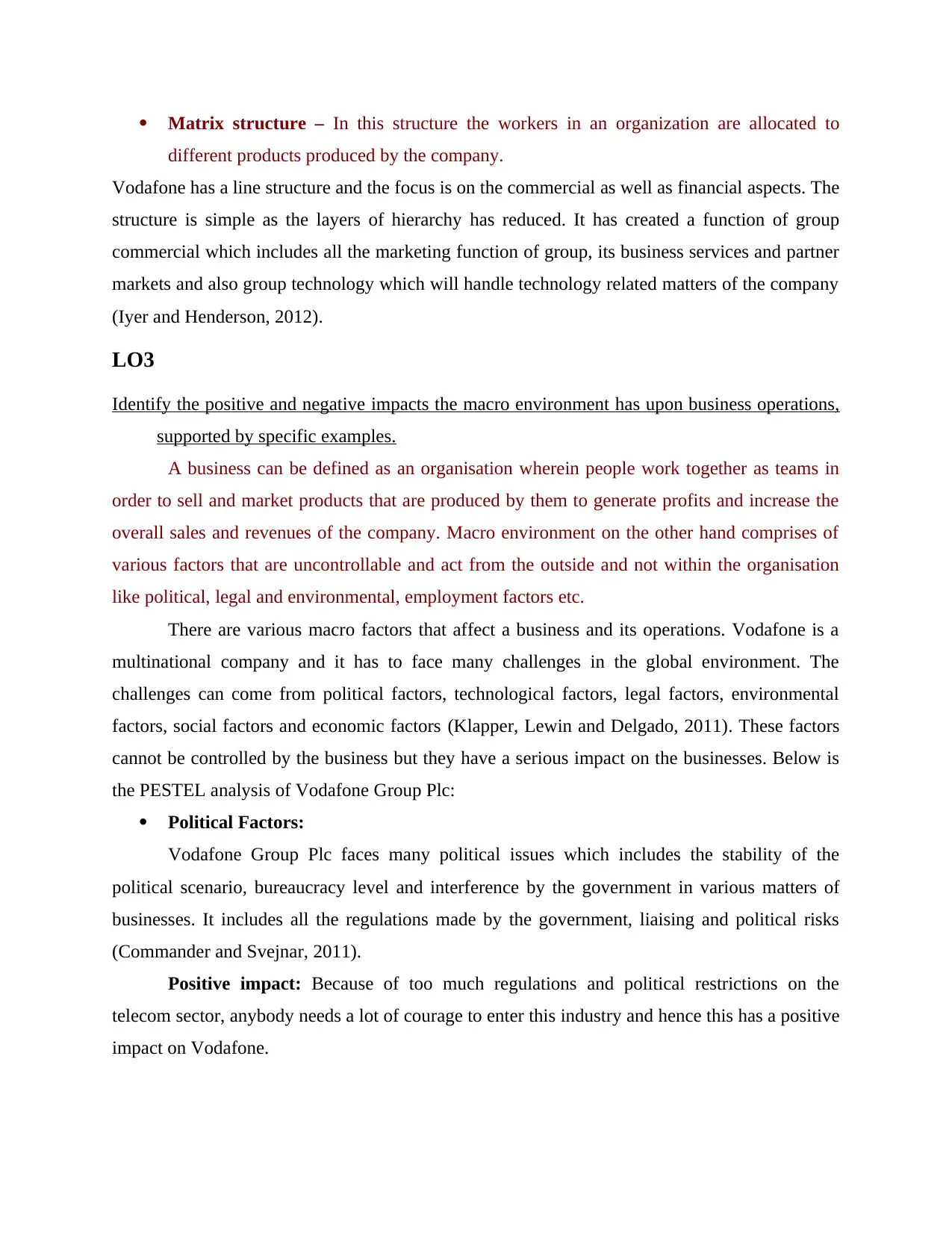
Matrix structure – In this structure the workers in an organization are allocated to
different products produced by the company.
Vodafone has a line structure and the focus is on the commercial as well as financial aspects. The
structure is simple as the layers of hierarchy has reduced. It has created a function of group
commercial which includes all the marketing function of group, its business services and partner
markets and also group technology which will handle technology related matters of the company
(Iyer and Henderson, 2012).
LO3
Identify the positive and negative impacts the macro environment has upon business operations,
supported by specific examples.
A business can be defined as an organisation wherein people work together as teams in
order to sell and market products that are produced by them to generate profits and increase the
overall sales and revenues of the company. Macro environment on the other hand comprises of
various factors that are uncontrollable and act from the outside and not within the organisation
like political, legal and environmental, employment factors etc.
There are various macro factors that affect a business and its operations. Vodafone is a
multinational company and it has to face many challenges in the global environment. The
challenges can come from political factors, technological factors, legal factors, environmental
factors, social factors and economic factors (Klapper, Lewin and Delgado, 2011). These factors
cannot be controlled by the business but they have a serious impact on the businesses. Below is
the PESTEL analysis of Vodafone Group Plc:
Political Factors:
Vodafone Group Plc faces many political issues which includes the stability of the
political scenario, bureaucracy level and interference by the government in various matters of
businesses. It includes all the regulations made by the government, liaising and political risks
(Commander and Svejnar, 2011).
Positive impact: Because of too much regulations and political restrictions on the
telecom sector, anybody needs a lot of courage to enter this industry and hence this has a positive
impact on Vodafone.
different products produced by the company.
Vodafone has a line structure and the focus is on the commercial as well as financial aspects. The
structure is simple as the layers of hierarchy has reduced. It has created a function of group
commercial which includes all the marketing function of group, its business services and partner
markets and also group technology which will handle technology related matters of the company
(Iyer and Henderson, 2012).
LO3
Identify the positive and negative impacts the macro environment has upon business operations,
supported by specific examples.
A business can be defined as an organisation wherein people work together as teams in
order to sell and market products that are produced by them to generate profits and increase the
overall sales and revenues of the company. Macro environment on the other hand comprises of
various factors that are uncontrollable and act from the outside and not within the organisation
like political, legal and environmental, employment factors etc.
There are various macro factors that affect a business and its operations. Vodafone is a
multinational company and it has to face many challenges in the global environment. The
challenges can come from political factors, technological factors, legal factors, environmental
factors, social factors and economic factors (Klapper, Lewin and Delgado, 2011). These factors
cannot be controlled by the business but they have a serious impact on the businesses. Below is
the PESTEL analysis of Vodafone Group Plc:
Political Factors:
Vodafone Group Plc faces many political issues which includes the stability of the
political scenario, bureaucracy level and interference by the government in various matters of
businesses. It includes all the regulations made by the government, liaising and political risks
(Commander and Svejnar, 2011).
Positive impact: Because of too much regulations and political restrictions on the
telecom sector, anybody needs a lot of courage to enter this industry and hence this has a positive
impact on Vodafone.
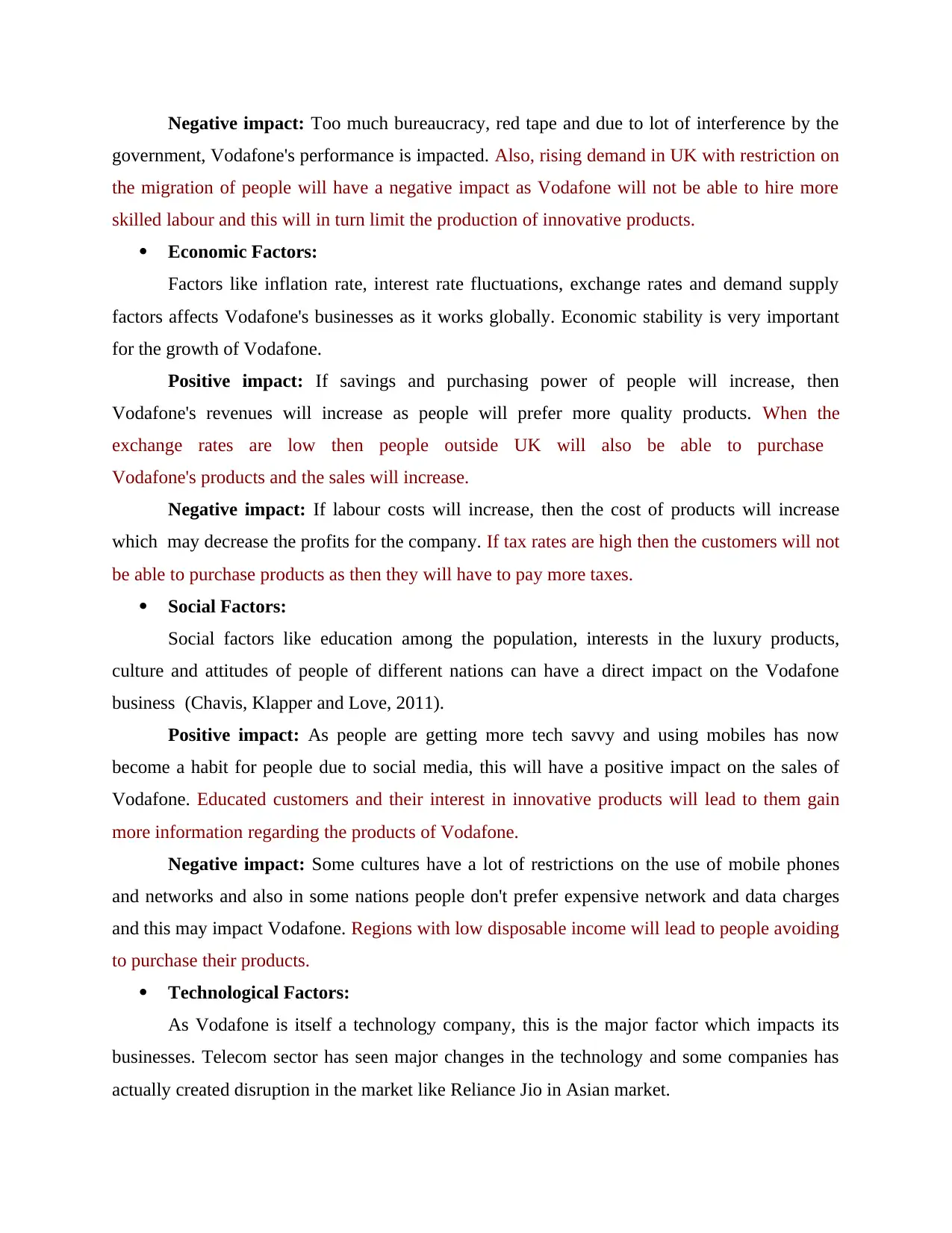
Negative impact: Too much bureaucracy, red tape and due to lot of interference by the
government, Vodafone's performance is impacted. Also, rising demand in UK with restriction on
the migration of people will have a negative impact as Vodafone will not be able to hire more
skilled labour and this will in turn limit the production of innovative products.
Economic Factors:
Factors like inflation rate, interest rate fluctuations, exchange rates and demand supply
factors affects Vodafone's businesses as it works globally. Economic stability is very important
for the growth of Vodafone.
Positive impact: If savings and purchasing power of people will increase, then
Vodafone's revenues will increase as people will prefer more quality products. When the
exchange rates are low then people outside UK will also be able to purchase
Vodafone's products and the sales will increase.
Negative impact: If labour costs will increase, then the cost of products will increase
which may decrease the profits for the company. If tax rates are high then the customers will not
be able to purchase products as then they will have to pay more taxes.
Social Factors:
Social factors like education among the population, interests in the luxury products,
culture and attitudes of people of different nations can have a direct impact on the Vodafone
business (Chavis, Klapper and Love, 2011).
Positive impact: As people are getting more tech savvy and using mobiles has now
become a habit for people due to social media, this will have a positive impact on the sales of
Vodafone. Educated customers and their interest in innovative products will lead to them gain
more information regarding the products of Vodafone.
Negative impact: Some cultures have a lot of restrictions on the use of mobile phones
and networks and also in some nations people don't prefer expensive network and data charges
and this may impact Vodafone. Regions with low disposable income will lead to people avoiding
to purchase their products.
Technological Factors:
As Vodafone is itself a technology company, this is the major factor which impacts its
businesses. Telecom sector has seen major changes in the technology and some companies has
actually created disruption in the market like Reliance Jio in Asian market.
government, Vodafone's performance is impacted. Also, rising demand in UK with restriction on
the migration of people will have a negative impact as Vodafone will not be able to hire more
skilled labour and this will in turn limit the production of innovative products.
Economic Factors:
Factors like inflation rate, interest rate fluctuations, exchange rates and demand supply
factors affects Vodafone's businesses as it works globally. Economic stability is very important
for the growth of Vodafone.
Positive impact: If savings and purchasing power of people will increase, then
Vodafone's revenues will increase as people will prefer more quality products. When the
exchange rates are low then people outside UK will also be able to purchase
Vodafone's products and the sales will increase.
Negative impact: If labour costs will increase, then the cost of products will increase
which may decrease the profits for the company. If tax rates are high then the customers will not
be able to purchase products as then they will have to pay more taxes.
Social Factors:
Social factors like education among the population, interests in the luxury products,
culture and attitudes of people of different nations can have a direct impact on the Vodafone
business (Chavis, Klapper and Love, 2011).
Positive impact: As people are getting more tech savvy and using mobiles has now
become a habit for people due to social media, this will have a positive impact on the sales of
Vodafone. Educated customers and their interest in innovative products will lead to them gain
more information regarding the products of Vodafone.
Negative impact: Some cultures have a lot of restrictions on the use of mobile phones
and networks and also in some nations people don't prefer expensive network and data charges
and this may impact Vodafone. Regions with low disposable income will lead to people avoiding
to purchase their products.
Technological Factors:
As Vodafone is itself a technology company, this is the major factor which impacts its
businesses. Telecom sector has seen major changes in the technology and some companies has
actually created disruption in the market like Reliance Jio in Asian market.
⊘ This is a preview!⊘
Do you want full access?
Subscribe today to unlock all pages.

Trusted by 1+ million students worldwide
1 out of 19
Related Documents
Your All-in-One AI-Powered Toolkit for Academic Success.
+13062052269
info@desklib.com
Available 24*7 on WhatsApp / Email
![[object Object]](/_next/static/media/star-bottom.7253800d.svg)
Unlock your academic potential
Copyright © 2020–2025 A2Z Services. All Rights Reserved. Developed and managed by ZUCOL.





